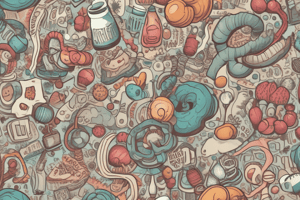Podcast
Questions and Answers
What are the monomers of carbohydrates called?
What are the monomers of carbohydrates called?
- Nucleotides
- Fatty acids
- Monosaccharides (correct)
- Amino acids
Which of the following elements are found in all carbohydrates?
Which of the following elements are found in all carbohydrates?
- Carbon, Hydrogen, Oxygen (correct)
- Iron, Magnesium, Zinc
- Sodium, Potassium, Chlorine
- Carbon, Nitrogen, Phosphorus
What is the general formula for a monosaccharide?
What is the general formula for a monosaccharide?
- $C_nH_{n}O_{2n}$
- $C_{n}H_{n}O_{3n}$
- $C_{2n}H_{n}O_{n}$
- $C_nH_{2n}O_n$ (correct)
Which compound is a very important monosaccharide that can provide energy or be polymerized?
Which compound is a very important monosaccharide that can provide energy or be polymerized?
What category do larger carbohydrates like sucrose and starch belong to?
What category do larger carbohydrates like sucrose and starch belong to?
How many structural isomers does glucose have?
How many structural isomers does glucose have?
Which type of bond is formed between two monosaccharides in a disaccharide?
Which type of bond is formed between two monosaccharides in a disaccharide?
What is the product of combining glucose and galactose?
What is the product of combining glucose and galactose?
In a hydrolysis reaction of a disaccharide, what is added to break the bond?
In a hydrolysis reaction of a disaccharide, what is added to break the bond?
Which carbon atoms are involved in the 1-4 glycosidic bond?
Which carbon atoms are involved in the 1-4 glycosidic bond?
What type of reaction creates a disaccharide by removing a water molecule?
What type of reaction creates a disaccharide by removing a water molecule?
Flashcards are hidden until you start studying
Study Notes
Carbohydrates
- Carbohydrates are biological molecules that store energy and provide structural support to plant cells.
- They are classified into three groups based on the number of units they are made of.
Monosaccharides
- Monosaccharides are the monomers of carbohydrates and are also known as sugars.
- They are soluble in water and have two main functions: providing energy or acting as building blocks to create larger molecules.
- Examples of monosaccharides include glucose, galactose, and fructose.
- The general formula for a monosaccharide is CnH2nOn, where n is the number of carbon atoms it contains.
- Carbohydrates contain three elements: carbon, hydrogen, and oxygen (CHO).
Glucose
- Glucose is a crucial monosaccharide that can provide energy or be polymerized to form structural support molecules (cellulose) or energy storage molecules (glycogen and starch).
- Glucose has two structural isomers: α glucose and β glucose.
- The only difference between these isomers is the arrangement of the hydrogen (H) and hydroxyl group (OH) on carbon 1.
Disaccharides
- Disaccharides are formed by bonding two monosaccharides together through a glycosidic bond, created by a condensation reaction.
- Three key disaccharides to remember are:
- Maltose (glucose + glucose)
- Lactose (glucose + galactose)
- Sucrose (glucose + fructose)
Condensation and Hydrolysis Reactions
- A condensation reaction creates a disaccharide by removing a water molecule from the hydroxyl group (OH) on carbon 1 and carbon 4 of two monosaccharides.
- The resulting bond is called a glycosidic bond.
- Disaccharides can be broken down into monosaccharides through a hydrolysis reaction, where a water molecule is added to break the bond.
Studying That Suits You
Use AI to generate personalized quizzes and flashcards to suit your learning preferences.




